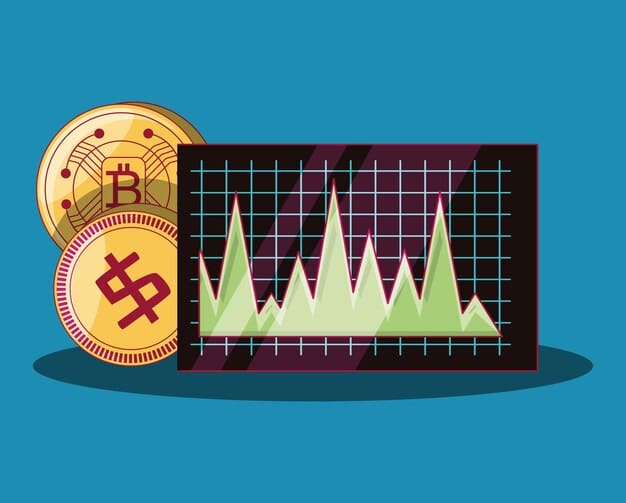Crypto & Inflation: Your Guide to Protecting Investments in the US Economy

Crypto and inflation are intertwined in today’s US economy, making it crucial to understand how to safeguard your investments amid fluctuating values and market uncertainties.
Navigating the intersection of crypto and inflation in the US economy can feel like a daunting task. Understanding how these two forces interact and developing strategies to protect your investments is crucial for long-term financial stability. Let’s explore effective methods to safeguard your assets in the current economic climate.
Understanding the Relationship Between Crypto and Inflation
The relationship between crypto and inflation is complex and debated. Some believe that cryptocurrencies, particularly Bitcoin, can act as a hedge against inflation due to their limited supply. Others argue that crypto’s volatility makes it an unreliable store of value during inflationary periods. Let’s delve deeper into understanding this connection.
Crypto as a Potential Inflation Hedge
The idea that crypto can serve as an inflation hedge stems from the fact that many cryptocurrencies have a finite supply. Unlike traditional fiat currencies, which can be printed by central banks, the supply of Bitcoin, for example, is capped at 21 million coins. This scarcity is thought to protect its value when fiat currencies lose purchasing power due to inflation.
Volatility and Inflation
However, cryptocurrencies are known for their volatility. This high volatility can make them a risky asset during inflationary periods. While some investors see dips as buying opportunities, the uncertainty can be unsettling for those seeking a stable store of value.

In conclusion, the relationship between crypto and inflation is not straightforward. While some cryptocurrencies may act as an inflation hedge, their volatility needs careful consideration.
Diversifying Your Crypto Portfolio
Diversification is a cornerstone of sound investment strategy, especially in the volatile world of cryptocurrencies. By spreading your investments across different types of crypto assets, you can reduce your exposure to risk and potentially enhance your returns. Let’s explore how to diversify your crypto portfolio effectively.
- Explore Different Cryptocurrencies: Don’t put all your eggs in one basket. Invest in a variety of cryptocurrencies, including established ones like Bitcoin and Ethereum, as well as promising altcoins with different use cases.
- Consider Stablecoins: Stablecoins are cryptocurrencies pegged to a stable asset like the US dollar. They can provide a safe haven during turbulent market conditions and offer opportunities for earning interest through staking or lending.
- Invest in Crypto-Related Stocks: Another way to diversify is to invest in companies that are involved in the crypto industry, such as cryptocurrency exchanges, blockchain technology providers, and crypto mining companies.
Diversification helps to mitigate risk. It is an important tool for navigating the crypto market.
Assessing Risk Tolerance and Investment Goals
Before investing in crypto, it’s vital to assess your risk tolerance and define your investment goals. Understanding your comfort level with risk and what you hope to achieve with your investments will guide your decision-making process and help you choose appropriate investment strategies. Consider your financial situation and how much of your capital you are prepared to put into crypto.
Understanding Risk Tolerance
Risk tolerance refers to your ability and willingness to withstand potential investment losses. Factors such as your age, income, financial goals, and investment experience can influence your risk tolerance. If you are risk-averse, you may prefer to allocate a smaller portion of your portfolio to crypto and focus on more conservative investments.
Defining Investment Goals
Setting clear investment goals is essential for staying on track and measuring your progress. Are you investing for long-term growth, income generation, or short-term gains? Your investment goals will determine the types of crypto assets you choose and the strategies you employ.

Assessing your risk tolerance and setting investment goals are crucial steps in ensuring your crypto investments align with your financial objectives and comfort level.
Leveraging DeFi Platforms for Yield Farming and Staking
Decentralized finance (DeFi) platforms offer opportunities to earn passive income on your crypto holdings through yield farming and staking. These activities involve lending or staking your crypto assets to earn rewards in the form of additional tokens or interest payments. It’s an opportunity to increase your holdings.
Understanding Yield Farming
Yield farming involves lending or staking your crypto assets on DeFi platforms to earn rewards. In return for providing liquidity to the platform, you receive tokens or interest payments as incentives. However, yield farming can be risky due to impermanent loss and smart contract vulnerabilities.
Exploring Staking Opportunities
Staking involves holding and locking up your crypto assets in a staking pool to support the operation of a blockchain network. In return for staking your tokens, you earn rewards in the form of additional tokens or a percentage of transaction fees. Staking can be a more stable source of passive income than yield farming.
- Research DeFi Platforms: Before participating in yield farming or staking, research different DeFi platforms to assess their reputation, security, and potential returns.
- Understand the Risks: Be aware of the risks involved, including impermanent loss, smart contract vulnerabilities, and regulatory changes.
- Diversify Across Platforms: Spread your DeFi investments across multiple platforms to reduce your exposure to risk.
DeFi yields increase your overall holdings of crypto.
Monitoring Market Trends and Economic Indicators
Staying informed about market trends and economic indicators is essential for making informed investment decisions in the crypto market. Economic indicators such as inflation data, interest rates, and GDP growth can influence the value of cryptocurrencies and impact investment strategies.
Keeping Track of Inflation Data
Monitoring inflation data is crucial for understanding the impact of inflation on the value of your crypto holdings. Keep an eye on the Consumer Price Index (CPI) and the Producer Price Index (PPI) to gauge inflation levels and adjust your investment strategies accordingly.
Analyzing Interest Rate Movements
Changes in interest rates can also affect the crypto market. Rising interest rates may lead to a decrease in demand for riskier assets like cryptocurrencies, while falling interest rates may have the opposite effect. Monitor interest rate announcements from the Federal Reserve to anticipate potential market movements.
Economic indicators affect the value of your holdings, so stay informed.
Rebalancing Your Portfolio Regularly
Rebalancing your portfolio is the process of adjusting your asset allocation back to your target levels. Over time, the value of different assets in your portfolio may change, causing your asset allocation to drift away from your original plan. Rebalancing helps you maintain your desired risk profile and capture opportunities to buy low and sell high.
Why Rebalance Your Portfolio?
Rebalancing helps you maintain your desired risk profile and capture opportunities to buy low and sell high. It also prevents your portfolio from becoming overly concentrated in one asset class, which can increase your exposure to risk.
How to Rebalance Your Portfolio
There are several ways to rebalance your portfolio. One approach is to rebalance on a periodic basis, such as quarterly or annually. Another approach is to rebalance when your asset allocation deviates significantly from your target levels.
- Determine Your Target Asset Allocation: Decide how much of your portfolio you want to allocate to different asset classes, such as stocks, bonds, and cryptocurrencies.
- Monitor Your Portfolio: Track the performance of your investments and compare your current asset allocation to your target allocation.
- Rebalance When Necessary: Rebalance your portfolio by buying or selling assets as needed to bring your asset allocation back in line with your target levels.
Rebalancing is a tool to manage risks and opportunities in investing.
| Key Point | Brief Description |
|---|---|
| 🛡️ Diversification | Spread investments across different crypto assets to reduce risk. |
| 🎯 Risk Assessment | Understand your risk tolerance and investment goals before investing. |
| 🌾 Leveraging DeFi | Use DeFi platforms for yield farming and staking to earn passive income. |
| 📊 Market Monitoring | Stay informed about market trends and economic indicators to make informed decisions. |
Frequently Asked Questions
▼
Some cryptocurrencies, like Bitcoin, have a limited supply and are seen as potential inflation hedges. However, crypto’s volatility can make it a risky option during inflationary periods.
▼
Diversification involves spreading your investments across different cryptocurrencies and crypto-related assets to reduce risk. Investing in various assets can balance risks.
▼
Consider your age, income, financial goals, and investment experience to determine your risk tolerance. If you’re risk-averse, allocate a smaller part of your portfolio to crypto.
▼
Yield farming involves lending crypto on DeFi platforms for rewards, while staking involves holding crypto to support blockchain operations for rewards. Both options generate passive income.
▼
Rebalancing ensures the target risk is managed, as asset values change. It can also help to ensure that profits are taken in assets that have seen price increases.
Conclusion
Protecting your investments in the face of inflation requires a well-thought-out strategy that considers the unique characteristics of the crypto market. By diversifying your portfolio, understanding your risk tolerance, and staying informed about market trends, you can navigate the challenges of crypto and inflation and position yourself for long-term financial success in the US economy.





